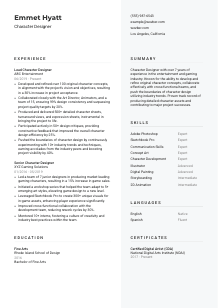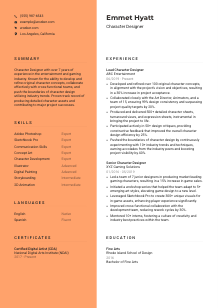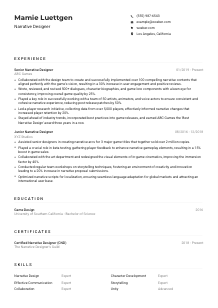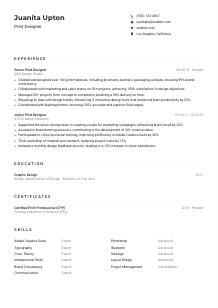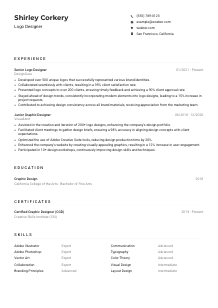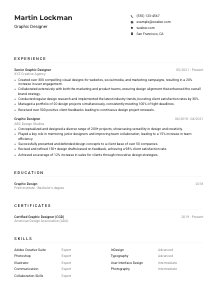Character Designer Resume Example
Bringing characters to life, but your resume feels 2D? Dive into this Character Designer resume example, shaped with Wozber free resume builder. Learn how to illustrate your imaginative flair to meet job expectations, ensuring your creative career leaps straight off the page!

How to write a Character Designer Resume?
Hey there, aspiring Character Designer! Do you feel like your resume might be blending into the background? Fear not, because with the right brush strokes and flourishes, you can make it pop and catch the eye of recruiters. Utilizing the Wozber free resume builder, this guide will escort you through the ins and outs of creating a resume that not only aligns with your dream job's demands but also passes the stringent checks of Applicant Tracking Systems (ATS).
Ready to sculpt your resume into a masterpiece that secures your position in the Character Design world? Let's dive in!
Personal Details
The Personal Details section is like the background of your canvas – it sets the stage. Let's ensure it shines bright with specifics that cater to the Character Designer role. Each detail, when brushed with intention, can significantly enhance your resume's appeal to potential employers.
1. Illustrate Your Name
Think of your name as the title of your masterpiece; it needs to be memorable. Opt for a clear, professional font that stands out without overpowering the rest of the canvas. Simply put, make your name the focal point of the top of your resume.
2. Sketch Your Ambitions
Directly beneath your name, align your ambitions with the role by mentioning "Character Designer." This small but mighty detail acts as a beacon, guiding the hiring manager's eye and affirming your aspirations.
3. Detail Your Contact Information
Your phone number and professional email address are like the coordinates to find your work. Ensure they're clearly listed, proofread for accuracy, and use a sensible email format like firstname.lastname@email.com to maintain a professional sheen.
4. Frame Your Location
The job description calls for a Los Angeles, California, location. Making it clear you're based in LA or willing to relocate can color you as a practical choice, removing any potential logistical concerns right from the start.
5. Exhibit Your Online Portfolio
In the realm of Character Design, a portfolio speaks volumes. Including a link to your professional website or portfolio within this section provides instant access to your work, allowing hiring managers to visualize your skill.
Takeaway
Like picking the right palette for a drawing, ensuring your Personal Details are concise, professional, and tailored to the Character Designer role sets the tone. Think of each detail as a stroke contributing to the bigger picture. Keep it neat, and align every detail with your creative identity.





Experience
The Experience section is your gallery, showcasing your artistic journey. Here, you illustrate how each role you've held contributes to a cohesive story of a skilled Character Designer. Let's paint a picture that captivates and compels your future employer to see your potential.
- Developed and refined over 100 original character concepts, in alignment with the project's vision and objectives, resulting in a 30% increase in project acceptance.
- Collaborated closely with the Art Director, Animators, and a team of 15, ensuring 99% design consistency and surpassing project quality targets by 20%.
- Produced and delivered 500+ detailed character sheets, turnaround views, and expression sheets, instrumental in bringing the project to life.
- Participated actively in 50+ design critiques, providing constructive feedback that improved the overall character design efficiency by 25%.
- Pushed the boundaries of character design by continuously experimenting with 10+ industry trends and techniques, earning accolades from the industry peers and boosting project visibility by 40%.
- Led a team of 7 junior designers in producing market‑leading gaming characters, resulting in a 15% increase in game sales.
- Initiated a workshop series that helped the team adapt to 5+ emerging art styles, elevating game design to a new level.
- Leveraged Sketchbook Pro to create 300+ unique visuals for in‑game assets, enhancing player experience significantly.
- Improved cross‑functional collaboration with the development team, reducing rework cycles by 30%.
- Mentored 10+ interns, fostering a culture of creativity and industry best practices within the team.
1. Outline the Job Essentials
Begin by dissecting the job description. Highlight phrases like "develop and refine original character concepts" or "collaborate closely with Art Directors." These lines are your guides, steering your experience narratives.
2. Compose Your Artistic Timeline
Organize your roles in chronological order, with the most recent experience first. This timeline tells the story of your artistic evolution, showcasing growth and impact in each position held.
3. Paint Your Achievements
For each position, detail accomplishments that resonate with the job's requirements. Did you develop over 100 original character concepts? Mention it! This specificity draws attention and paints a vivid picture of your capabilities.
4. Highlight Your Collaborative Palette
Emphasize collaborative skills and your ability to mesh with cross-functional teams, reflecting requirements like "strong interpersonal and communication skills." This shows you're not only skilled but also a team player.
5. Add Depth with Quantifiable Achievements
Whenever possible, add numbers to give depth to your accomplishments. Saying "resulted in a 30% increase in project acceptance" adds perspective and magnitude to your contribution, making your achievements more tangible to hiring managers.
Takeaway
Your experience section isn't just a list; it's the narrative of your professional evolution towards becoming an exceptional Character Designer. Curate your achievements to showcase not just where you've been, but also hint at the heights you can reach. Choosing the right experiences and presenting them effectively is your ticket to standing out.
Education
The Education section can be more than a mere formality; it's the scaffolding of your expertise. By aligning your academic qualifications with the role's requirements, you create a sturdy foundation that supports your quest for the Character Designer position.
1. Frame Your Degree
Firstly, mirror the specific educational criteria from the job requirements, such as a "Bachelor's degree in Illustration, Animation, Fine Arts." This directly shows that your educational background is in perfect harmony with what they're looking for.
2. Paint a Simple Structure
Maintain clarity and directness with the structure of this section—detail your degree, the field of study, and the institution, followed by the year of graduation. Remember, simplicity enables the important details to stand out.
3. Draw Attention to Relevant Courses
If you've taken specialized courses that align closely with the character design role, such as digital painting or animation principles, list them. This shows a commitment to your craft beyond the basic requirements.
4. Illustrate Your Academic Accomplishments
Did you graduate with honors, or did you lead an animation project that won awards? Such details, while brief, add character to your educational background, suggesting a high level of dedication and success.
5. Detail Conclusive Achievements
If your education directly contributed to your success in any projects or roles, mention it succinctly. For instance, "Applied thesis work on character emotion portrayal to enhance character relatability in XYZ project."
Takeaway
Education is the bedrock of your career in Character Design. It establishes your fundamental qualifications and shows a trajectory of learning and passion for your field. Ensure this section validates your credentials while painting you as a continuous learner, eager to grow and innovate.
Certificates
While the job description might not specify certain certifications, showcasing relevant ones can add layers to your resume, highlighting your commitment to staying at the forefront of your craft. Let's navigate through this part, adding badges of honor to your artistic arsenal.
1. Curate with Purpose
Consider only including certifications that strengthen your candidacy for the Character Designer role. For example, a "Certified Digital Artist" demonstrates your recognized skills and dedication.
2. Exhibit Recent Achievements
Dates matter, especially in a swiftly evolving field like digital art. Highlight recent certifications to show you're up to date with the latest trends and technologies.
3. Display with Clarity
When listing certifications, include the title, issuing organization, and date earned. Clear and concise formatting allows each certification to stand out as a testament to your continuous professional development.
4. Continuously Update Your Palette
The art world doesn't stand still, nor should your learning. Regularly seek out new certifications and learning opportunities relevant to character design and digital art. This proactive approach demonstrates your commitment to growth and excellence.
Takeaway
Think of each certification as a brushstroke that adds depth and color to your professional portrait. While not the focal point, they complement your overall qualifications, highlighting your dedication to mastering your craft and staying relevant in the dynamic Character Designer landscape.
Skills
The Skills section is where you get to flaunt the tools and techniques you wield with mastery. In the Character Designer realm, your skills are your arsenal, and presenting them effectively can make your resume truly stand out.
1. Match Your Toolbox
Start by identifying skills from the job description, such as "expert proficiency in Adobe Photoshop, Illustrator." These are non-negotiable skills that you should prominently display in your resume to align with the role's requirements.
2. Blend Hard and Soft Skills
Balance your technical skills with softer, interpersonal ones. Skills like "strong interpersonal and communication skills" are crucial for collaborating effectively with art directors and animators, showing that you're not just technically competent but also a team player.
3. Arrange with Precision
List your skills in a way that mixes both hard and soft skills, showcasing your versatility. Organize them based on their relevance to the Character Designer role, ensuring that the most critical skills catch the hiring manager's eye first.
Takeaway
Your skills section is a powerful showcase of your capabilities. By aligning it closely with the job requirements and exhibiting a mix of technical prowess and interpersonal finesse, you present yourself as a well-rounded candidate prepared to take on the Character Designer role's challenges.
Languages
In the diverse and collaborative world of character design, the ability to communicate in multiple languages can be an added bonus. Let's add this finishing touch, demonstrating your ability to engage with a global audience.
1. Speak the Required Language
Given that "competence in both spoken and written English is essential" for this job, your proficiency in English should be prominently listed to meet the basic communication requirements.
2. Showcase Additional Languages
If you speak languages beyond English, list them to highlight your capacity for broader communication, especially useful in diverse teams or international projects. This speaks to your versatility and global perspective.
3. Rate Your Fluency
Be transparent about your proficiency levels—whether native, fluent, intermediate, or basic. This honesty helps set realistic expectations and showcases your learning areas.
4. Understand the Role's Global Scope
For roles involving collaborative teams from around the globe or projects that reach international markets, your multilingual abilities could offer a significant advantage.
5. Reflect on Your Market Reach
Consider how your language skills could impact your role. Could your fluency in Spanish open new market opportunities for character design? Highlighting this potential shows foresight and initiative.
Takeaway
Your linguistic prowess adds nuances to your professional profile, illustrating your readiness to interact in a multicultural industry. Embrace this diversity in your resume, showcasing your ability to bridge cultures through effective communication.
Summary
Your summary is the prologue of your professional story. It gives a sneak peek into your character, your journey, and the unique traits you bring to the Character Designer role. A well-crafted summary can intrigue recruiters and beckon them to explore your resume further.
1. Set the Stage
Introduce yourself with a snapshot of your professional identity, emphasizing your years of experience and particular strengths like your "ability to develop and refine original character concepts."
2. Highlight Your Main Characters
Bring to light a few key skills and achievements that directly answer the job's call, such as your proficiency in industry-standard software and your collaborative prowess. Frame these attributes as the stars of your professional story.
3. Make It a Bestseller
Keep your summary engaging yet concise, within 3-5 lines. This teaser should entice the hiring manager to read on, intrigued by the professional narrative you're about to unfold.
4. Tailor for the Audience
Always write with the potential employer in mind. How does your story fit into the broader narrative of what they're seeking for the role? Show them how you're not just a character designer but the Character Designer they need.
Takeaway
Your summary is the opening scene to the epic of your professional journey. With a clear, tailored introduction, you set the tone for the rest of your resume, captivating the hiring manager's interest from the very beginning. This is your moment to shine—make every word count.
Your Masterpiece Awaits
You've now journeyed through the steps to carve your Character Designer resume into not just a document, but a portrait of your potential. Remember, your resume is like a gallery of your professional highlights, designed to capture and hold the attention of those who gaze upon it. Use Wozber free resume builder to shape your experiences, education, and skills into an ATS-compliant masterpiece. With the right tools like the ATS friendly resume template and ATS resume scanner, your document will pass through the digital gatekeepers and into the hands of those eager to welcome your talent aboard.
Embrace the process, let your creativity lead the way, and step confidently into the world of opportunities awaiting you. Your next chapter is just a submission away. Happy creating!

- Bachelor's degree in Illustration, Animation, Fine Arts, or a related field.
- Minimum of 3 years of professional experience in character design, preferably in the entertainment or gaming industry.
- Expert proficiency in industry-standard software such as Adobe Photoshop, Illustrator, and Sketchbook Pro.
- Solid understanding of diverse art styles, with the ability to adapt and create unique visuals.
- Strong interpersonal and communication skills, with the ability to collaborate effectively with cross-functional teams.
- Competence in both spoken and written English is essential.
- Must be located in Los Angeles, California.
- Develop and refine original character concepts in alignment with the project's vision and objectives.
- Collaborate closely with the Art Director, Animators, and other team members to ensure design consistency and quality.
- Produce detailed character sheets, turnaround views, and expression sheets for production use.
- Participate in design critiques, providing and accepting feedback to improve the overall character design.
- Stay up-to-date with industry trends and techniques, consistently pushing the boundary of character design.






